Lightweights fit all forms of work
Page 60
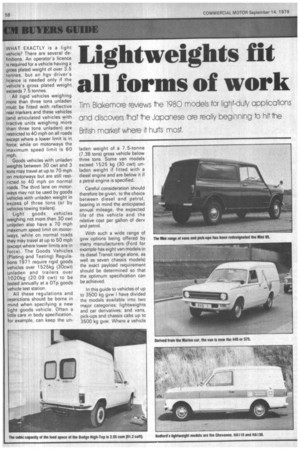
Page 61
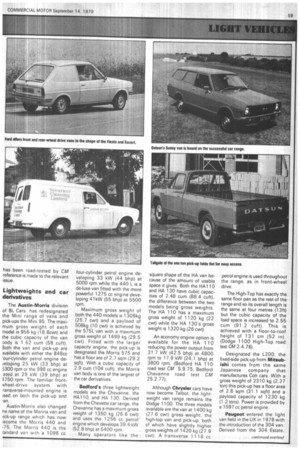
Page 62
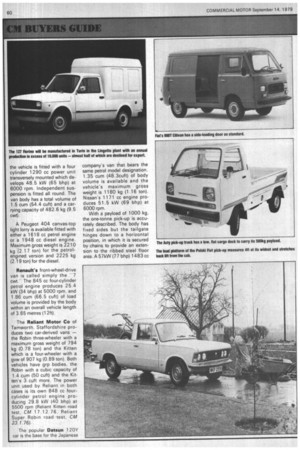
Page 63
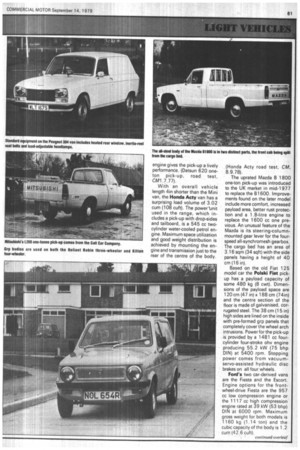
Page 64
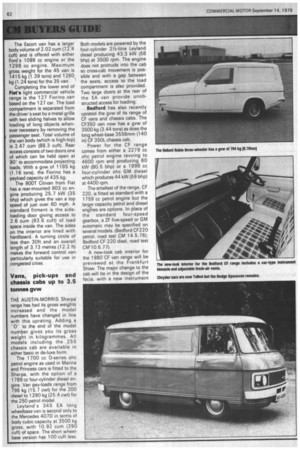
Page 65
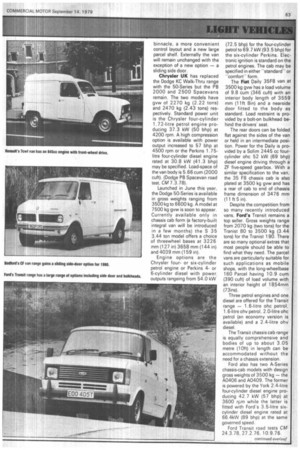
Page 66
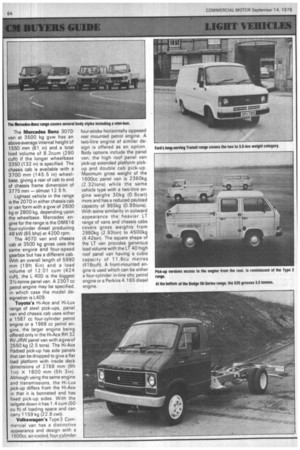
If you've noticed an error in this article please click here to report it so we can fix it.
Tim Blakemore reviews the 1980 models for light-du-y applications and discovers --'-)at the Japanese are really beginning to hit the British market where it hurts most.
WHAT EXACTLY is a light vehicle? There are several definitions. An operator's licence is required for a vehicle having a gross plated weight of over 3.5 tonnes, but an hgv driver's licence is needed only if the vehicle's gross plated weight exceeds 7.5 tonnes.
All rigid vehicles weighing more than three tons unladen must be fitted with reflective rear markers and these vehicles (and articulated vehicles with tractive units weighing more than three tons unladen) are restricted to 40 mph on all roads except where a lower limit is in force, while on motorways the maximum speed limit is 60 mph.
Goods vehicles with unladen weights between 30 cwt and 3 tons may travel at up to 70 mph on motorways but are still restricted to 40 mph on normal roads. The third lane on motorways may not be used by goods vehicles with unladen weight in excess of three tons (or by vehicles towing trailers).
Light goods vehicles weighing not more than 30 cwt unladen also have a 70 mph maximum speed limit on motorways, while on normal roads they may travel at up to 50 mph (except where lower limits are in force). The Goods Vehicles (Plating and Testing) Regulations 1971 require rigid goods vehicles over 1525kg (30cwt) unladen and trailers over 1020kg (20.09 cwt) to be tested annually at a DTp goods vehicle test station.
All these regulations and restrictions should be borne in mind when specifying a new light goods vehicle. Often a little care in body specification, for example, can keep the un
laden weight of a 7.5-tonne (7.38 tons) gross vehicle below three tons. Some van models exceed 1525 kg (30 cwt) unladen weight if fitted with a diesel engine and are below it if a petrol engine is specified.
Careful consideration should therefore be given, to the choice between diesel and petrol, bearing in mind the anticipated annual mileage, the expected life of the vehicle and the relative cost per gallon of dery and petrol.
With such a wide range of gvw options being offered by many manufacturers (Ford for example has eight van models in its diesel Transit range alone, as well as seven chassis models) the exact payload requirement should be determined so that the optimum specification can be achieved.
In this guide to vehicles of up to 3500 kg gvw I have divided the models available into two major categories; lightweights and car derivatives; and vans, pick-ups and chassis cabs up to 3500 kg gvw. Where a vehicle
Lightweights and car derivatives
The Austin-Morris division of BL Cars. has redesignated the Mini range of vans and pick-ups the Mini 95. The maximum gross weight of each model is 956 kg (18.8cwt) and the cubic capacity of the van body is 1.62 cum (58 cuft). Both the van and pick-up are 3vailable with either the 848cc bur-cYlinder petrol engine de/eloping 25 kW (33 bhp) at 5300 rpm or the 998 cc engine • ated at 29 kW (39 bhp) at 1.750 rpm. The familiar front
vheel-drive system with ransverse-mounted engine is ised on both the pick-up and ,an.
Austin-Morris also changed he name of the Marina van and lick-up range which has now ,ecome the Morris 440 and p75. The Morris 440 is the tandard van with a 1098 cc
four-cylinder petrol engine developing 33 kW (44 bhp) at 5000 rpm while the 440 L is a de-luxe van fitted with the more powerful 1275 cc engine developing 41kW (55 bhp) at 5500 rpm.
Maximum gross weight of both the 440 models is 1306kg (25.7 cwt) and a payload of 508kg (10 cwt) is achieved by the 575L van with a maximum gross weight of 1499 kg (29.5 cwt). Fitted with the larger capacity engine, the pick-up is designated the Morris 575 and has a floor are of 27 sqm (29.2 sqft). With a cubic capacity of 2.9 cum (104 cuft), the Morris van body is one of the largest of the car derivatives.
Bedford's three lightweight models are the Chevanne, the HA110, and HA 130. Derived from the Chevette car range, the Chevanne has a maximum gross weight of 1350 kg (26.6 cwt) and uses the 1256 cc petrol engine which develops 39.4 kW (52.8 bhp) at 5400 rpm.
Many operators like the square shape of the HA van because of the amount of usable space it gives. Both the HA110 and HA 130 have cubic capacities of 2.48 cum (88.4 cuft), the difference between the two models being gross weights. The HA 110 has a maximum gross weight of 1120 kg (22 cwt) while the HA 130's gross weight is 1 320 kg (26 cwt).
An economy engine option is available for the HA 110 reducing the power output from 31.7 kW (42.5 bhp) at 4800 rpm to 17.9 kW (24.1 bhp) at 3800 rpm. (Bedford HA 110 road test CM 5.9.75, Bedford Chevanne road test CM 25.2.77),
Although Chrysler cars have now become Talbot, the lightweight van range remains the Dodge 1100. The three models available are the van at 1400 kg (27.6 cwt) gross weight, the high-top van and pick-up, both of which have slightly higher gross weights of 1420 kg (27.9 cwt). A transverse 1 1 1 8 cc petrol engine is used throughout the range, as in front-wheel drive.
The High-Top has exactly the same floor pan as the rest of the range and so its overall length is the same at four metres (13ft) but the cubic capacity of the load space is increased to 2.55 cum (91.2 cuft). This is achieved with a floor-to-roof height of 131 cm (52 in). (Dodge 1100 High-Top road test CM 2.4.76).
Designated the L200, the fixed-side pick-up from Mitsubishi comes from the same Japanese company that manufactures Colt cars. With a gross weight of 2310 kg (2.27 ton) this pick-up has a floor area of 2.8 sqm (31.1 sqft) and a payload capacity of 1230 kg (1.2 tons). Power is provided by a 1597 cc petrol engine.
Peugeot entered the light van field in the UK in 1978 with the introduction of the 304 van. Derived from the 304 Estate, the vehicle is fitted with a four cylinder 1290 cc power unit transversely mounted which develops 48.5 kW (65 bhp) at 6000 rpm. Independent suspension is fitted all round. The van body has a total volume of 1.5 cum (54.4 cuft) and a carrying capacity of 482.6 kg (9.5 cwt).
A Peugeot 404 canvas-top light lorry is available fitted with either a 1618 cc petrol engine or a 1948 cc diesel engine. Maximum gross weight is 2210 kg -(2.17 ton) for the petrolengined version and 2225 kg (2 19 ton) for the diesel.
Renault's front-wheel-drive van is called simply the -7 cwt.The 845 cc four-cylinder petrol engine produces 25.4 kW (34 bhp) at 5000 rpm, and 1.86 cum (66.5 cuft) of load volume is provided by the body within an overall vehicle length of 3 65 metres (12ft).
The Reliant Motor Co of Tamworth, Staffordshire produces two car-derived vans — the Robin three-wheeler with a maximum gross weight of 794 kg (0.78 ton) and the Kitten which is a four-wheeler with a gvw of 907 kg (0.89 ton). Both vehicles have grp bodies, the Robin with a cubic capacity of 1 4 cum (50 cuft) and the Kitten's 3 cuft more. The power unit used by Reliant in both cases is its own 848 cc fourcylinder petrol engine producing 29.8 kW (40 bhp) at 5500 rpm (Reliant Kitten road test, CM 17.1 276, Reliant Super Robin road test, CM 23.1.76).
The popular Datsun 120Y car is the base for the Japanese company's van that bears the same petrol model designation. 1.35 cum (48.3cuft) of body volume is available and the vehicle's maximum gross weight is 1180 kg (1.16 ton). Nissan's 1171 cc engine produces 51.5 kW (69 bhp) at 6000 rpm.
With a payload of 1000 kg, the one-tonne pick-up is accurately described. The body has fixed sides but the tailgate hinges down to a horizontal position, in which it is secured by chains to provide an extension to the ribbed steel floor area. A 57kW (77 bhp) 1483 cc engine gives the pick-up a lively performance. (Datsun 620 oneton pick-up, road test, CM1.7.77).
With an overall vehicle length 4in shorter than the Mini van, the Honda Acty van has a surprising load volume of 3.02 cum (108 cuft). The power unit used in the range, which includes a pick-up with drop-sides and tailboard, is a 545 cc twocylinder water-cooled petrol engine. Maximum space utilization and good weight distribution is achieved by mounting the engine and transmission just to the rear of the centre of the body. (Honda Acty road test, CM, 8.9.78).
The uprated Mazda B 1800 one-ton pick-up was introduced to the UK market in mid-1977 to replace the B1600. Improvements found on the later model include more comfort, increased payload area, better rust protection and a 1.8-litre engine to replace the 1600 cc one previous. An unusual feature of the Mazda is its steering-columnmounted gear lever for the fourspeed all-synchromesh gearbox. The cargo bed has an area of 3.16 sqm (34 sqft) with the side panels having a height of 40 cm (16 in).
Based on the old Fiat 125 model car the Polski Fiat pickup has a payload capacity of some 480 kg (8 cwt). Dimensions of the payload space are 120 cm (47 in) x 188 cm (74in) and the centre section of the floor is made of galvanised, corrugated steel. The 38 cm (15 in) high sides are lined on the inside with pre-formed grp panels that completely cover the wheel arch intrusions. Power for the pick-up is provided by a 1481 cc fourcylinder four-stroke ohv engine producing 55.2 kW (75 bhp DIN) at 5400 rpm. Stopping power comes from vacuumservo-assisted hydraulic disc brakes on all four wheels.
Ford's two car-derived vans are the Fiesta and the Escort. Engine options for the frontwheel-drive Fiesta are the 957 cc low compression engine or the 1117 cc high compression engine rated at 39 kW (53 bhp) DIN at 6000 rpm. Maximum gross weight for both models is 1160 kg (1.14 ton) and the cubic capacity of the body is 1.2 cum (42.6 cuft).
The Escort van has a larger body volume of 2.02 cum (724 cuft) and is offered with either Ford's 1098 cc engine or the 1298 cc engine. Maximum gross weight for the 45 van is 1415 kg (1.39 tons) and 1260 kg (1.24 tons) for the 35 van.
Completing the lower end of Fiat's light commercial vehicle range is the 127 Fiorino van based on the 127 car. The load compartment is separated from the driver's seat by a metal grille with two sliding halves to allow loading of long objects whenever necessary by removing the passenger seat. Total volume of the van body (which is high-top) is 2.47 cum (88,3 cuft). Rear access consists of two doors one of which can be held open at 90' to accommodate projecting loads. With a gvw of 1185 kg (1.16 tons), the Fiorino has a payload capacity of 435 kg.
The 900T Citivan from Fiat has a rear-mounted 903 cc engine producing 25.7 kW (35 bhp) which gives the van a top speed of just over 60 mph. A standard fitment is the sideloading door giving access to 2.6 cum (93.6 cuft) of load space inside the van. The sides on the interior are lined with hardboard. A turning circle of less than 30ft and an overall length of 3.73 metres (12.2 ft) makes the forward control van particularly suitable for use in congested cities.
Vans, pick-ups and chassis cabs up to 3.5 tonnes gvw
THE AUSTIN-MORRIS Sherpa range has had its gross weights increased and the model numbers have changed in line with this uprating. Adding a
-0to the end of the model number gives you its gross weight in kilogrammes. All models including the 255 chassis cab are available in either basic or de-luxe form.
The 1700 cc 0-series ohc petrol engine as used in Marina and Princess cars is fitted to the Sherpa, with the option of a 1789 cc four-cylinder diesel engine. Van pay-loads range from 796 kg (15.7 cwt) for the 200 diesel to 1290 kg (25.4 cwt) for the 250 petrol model.
Leyland's 345 EA long wheelbase van is second only to the Mercedes 407D in terms of body cubic capacity at 3500 kg gross, with • 10.92 cum (390 cuft) of space. The short wheelbase version has 100 cuft less.
Both models are powered by the four-cylinder 21/2-litre Leyland diesel producing 43.3 kW (58 bhp) at 3500 rpm. The engine does not protrude into the cab so cross-cab movement is possible and with a gap between the seats, access to the load compartment is also provided. Two large doors at the rear of the EA van provide unobstructed access for loading.
Bedford has also recently uprated the gvw of its range of CF vans and chassis cabs. The CF350 van now has a gvw of 3500 kg (3.44 tons) as does the long wheel-base 3556mm (140 in) CF 350L chassis cab.
Power for the CF range comes from either a 2279 cc ohc petrol engine revving to 4600 rpm and producing 60 kW (80.5 bhp) or a 1998 cc four-cylinder ohc GM diesel which produces 44 kW (59 bhp) at 4400 rpm.
The smallest of the range, CF 220, is fitted as standard with a 1759 cc petrol engine but the larger capacity petrol and diesel engines are options. In place of the standard four-speed gearbox, a ZF five-speed or GM automatic may be specified on several models. (Bedford CF220 petrol, road test CM 14.5.76): Bedford CF 220 disel, road test CM 10.6.77).
A new-look cab interior for the 1980 CF van range will be previewed at the Frankfurt Show. The major change to the cab will be in the design of the facia, with a new instrument binnacle, a more convenient control layout and a new large parcel shelf. Externally the van will remain unchanged with the exception of a new option — a sliding side door.
Chrysler UK has replaced the Dodge KC Walk-Thru range with the 50-Series but the PB 2000 and 2500 Spacevans remain. The two models have gvw of 2270 kg (2.22 tons) and 2470 kg (2.43 tons) respectively. Standard power unit is the Chrysler four-cylinder 1.72-litre petrol engine producing 37.3 kW (50 bhp) at 4200 rpm. A high compression option is available with power output increased to 57 bhp at 4500 rpm or the Perkins 1.75litre four-cylinder diesel engine rated at 30.8 kW (41.3 bhp) may be specified. Load-space of the van body is 5.66 cum (2000 cuft). (Dodge PB Spacevan road test, CM 7.3.78).
Launched in June this year, the Dodge 50-Series is available in gross weights ranging from 3500 kg to 6600 kg. A model at 7500 kg gvw is soon to appear. Currently available only in chassis cab form (a factory-built integral van will be introduced in a few months) the S 35 3.44 ton model offers a choice of threewheel bases at 3226 mm (127 in) 3658 mm (144 in) and 4039 mm (159 in).
Engine options are the Chrysler fouror six-cylinder petrol engine or Perkins 4or 6-cylinder diesel with power. outputs rangeing from 54.0 kW
(72.5 bhp) for the four-cylinder petrol to 69.7 kW (93.5 bhp) for the six-cylinder Perkins. Electronic ignition is standard on the petrol engines. The cab may be specified in either "standard" or -comfort" form.
The Fiat Daily 35F8 van at 3500 kg gvw has a load volume of 9.8 cum (346 cuft) with an interior body length of 3 559 mm (lift Sin). and a nearside door fitted to the body as standard. Load restraint is provided by a bolt-on bulkhead behind the drivers' seat.
The rear doors can be folded flat against the sides of the van or held in an intermediate position. Power for the Daily is provided by a Sofim 2445 cc fourcylinder ohc 52 kW (69 bhp) diesel engine driving through a ZF five-speed gearbox. With a similar specification to the van, the 35 F8 chassis cab is also plated at 3500 kg gvw and has a rear of cab to end of chassis frame dimension of 3476 mm (11 ft 5 in).
Despite the competition from
so many recently introduced vans, Ford's Transit remains a top seller. Gross weights range from 2070 kg (two tons) for the Tranist 80 to 3500 kg (3.44 tons) for the Tranist 190. There are so many optional extras that most people should be able to find what they need. The parcel vans are particularly suitable for such applications as mobile shops, with the long-wheelbase
160 Parcel having 10.9 cum (390 cuft) of load volume with an interior height of 1854mm (73ins).
Three petrol engines and one diesel are offered for the Transit range — 1.6-litre ohc petrol, 1.6-litre ohv petrol, 2.0-litre ohc petrol (an economy version is available) and a 2.4-litre ohv diesel.
The Transit chassis cab range is equally comprehensive and bodies of up to about 3.05 metre (10ft) in length can be accommodated without the need for a chassis extension.
Ford also has two A-Series chassis-cab models with design gross weights of 3500 kg — the A0406 and A0409. The former is powered by the York 2.4-litre four-cylinder diesel engine producing 42.7 kW (57 bhp) at 3600 rpm while the latter is fitted with Ford's 3.5-litre sixcylinder diesel engine rated at 66.4kW (89 bhp) at the same governed speed.
Ford Transit road tests CM 24.3.78, 27.2.76, 10.9,76. continued overleaf
The Mercedes Benz 307D van at 3500 kg gvw has an above-average internal height of 1550 mm (61.. in) and a total load volume of 8.2cum (290 cuft) if the longer wheelbase 3350 ( 1 3 2 in) is specified. The chassis cab is available with a 3700 mm (145.5 in) wheelbase, giving a rear of cab to end of chassis frame dimension of 3775 mm — almost 12.5 ft.
Lightest vehicle in the range is the 207D in either chassis cab or van form with a gvw of 2600 kg or 2800 kg, depending upon the wheelbase. Mercedes engine for the range is the 0 M616 four-cylinder diesel producing 48 kW (65 bhp) at 4200 rpm.
The 407D van and chassis cab at 3500 kg gross uses the same engine and four-speed gearbox but has a different cab. With an overall length of 5990 mm (19ft 6in) and a load volume of 12.01 cum (424 cuft), the L 40D is the biggest 31/2-tonne panel van. A 2307 cc petrol engine may be specified, in which case the model designation is L409.
Toyota's Hi-Ace and Hi-Lux range of steel pick-ups, panel van and chassis cab uses either a 1 587 cc four-cylinder petrol engine or a 1968 cc petrol engine, the larger engine being offered only in the Hi-Ace RH 32 RV-JRW panel van with a gvwof 2550 kg (2.5 tons). The Hi-Ace Flatbed pick-up has side panels that can be dropped to give a flat load platform with inside deck dimensions of 2768 mm (9ft 1in) x 1600 mm (5ft 3in). Although using the same engine and transmissions, the Hi-Lux pick-up differs from the Hi-Ace in that it is bonneted and has fixed pick-up sides. With the tailgate down it has 1.4 cum (50 cu ft) of loading space and can carry 11 59 kg (22.8 cwt).
Volkswagen's Type 3 Commercial van has a distinctive appearance and design with a 1600cc air-cooled four-cylinder four-stroke horizontally opposed rear mounted petrol engine. A two-litre engine of similar design is offered as an option. Body options include the panel van, the high roof panel van pick-up extended platform pickup and double cab pick-up. Maximum gross weight of the 1600cc panel van is 2360kg (2.32tons) while the same vehicle type with a two-litre engine weighs 30kg (0. 6cwt) more and has a reduced payload capacity of 965kg (0.95tons). With some similarity in outward appearance the heavier LT range of vans and chassis cabs covers gross weights from 2980kg (2.93ton) to 4500kg (4.42ton). The square shape of the LT van provides generous load volume with the LT 40 high roof panel van having a cubic capacity of 11.6cu metres (416cuft). A front-mounted engine is used which can be either a four-cylinder in-line ohc petrol engine or a Perkins 4.165 diesel engine.




















































































































































